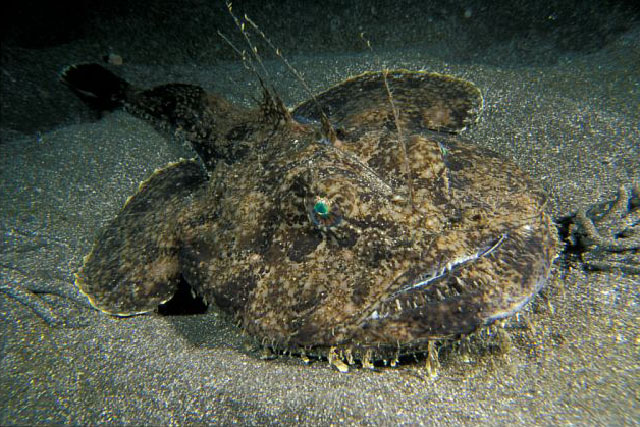| Lophiidae (Goosefishes) |
| 200 cm SL (male/unsexed); max.weight: 58 kg; max. reported age: 24 years |
|
bathydemersal; marine; depth range 20 - 1000 m |
| Eastern Atlantic: south-western Barents Sea to Strait of Gibraltar including the Mediterranean and Black Sea. Reported from Iceland (Ref. 4712) and Mauritania (Ref. 5377). North Atlantic specimens attain larger sizes than those collected off West Africa and they also occur in shallower depths. |
|
Dorsal spines (total): 8-8; Dorsal soft rays (total): 11-12; Anal soft rays: 9-10. Peritoneum pale. Head and body depressed. Mouth wide and cavernous. Skin thin and loose, scales absent. Esca bifid, 2 broad, flattened , leaf-like blades. Dorsal spines long, stout and bearing many well-developed tendrils; 4th spine greater than snout width (Ref. 4712). |
| Occurs on sandy and muddy bottoms from the coast (below 20 m, Ref. 12382) down to depths of 1,000 m. May also be found on rocky bottoms (Ref. 12382). It lies half-buried in the sediment waiting for its prey. It attracts prey by means of its fishing filament (Ref. 5377). Feeds mainly on fishes, occasionally sea-birds. Marketed fresh and frozen; eaten steamed, sautéed, broiled, boiled, fried, microwaved and baked (Ref. 9988). It is a well-studied species in Europe and is sold without the skin and the head under the name 'queue de Lotte' (Ref. 5377). Does not adapt well in home aquariums due to its large size (Ref. 12382). |
|
Least Concern (LC); Date assessed: 09 May 2013 Ref. (130435)
|
| harmless |
|
Source and more info: www.fishbase.org. For personal, classroom, and other internal use only. Not for publication.

